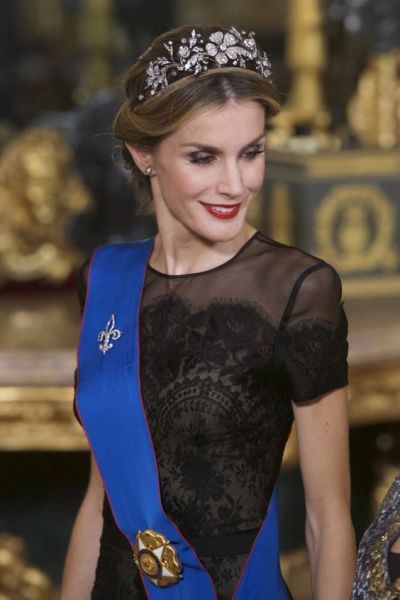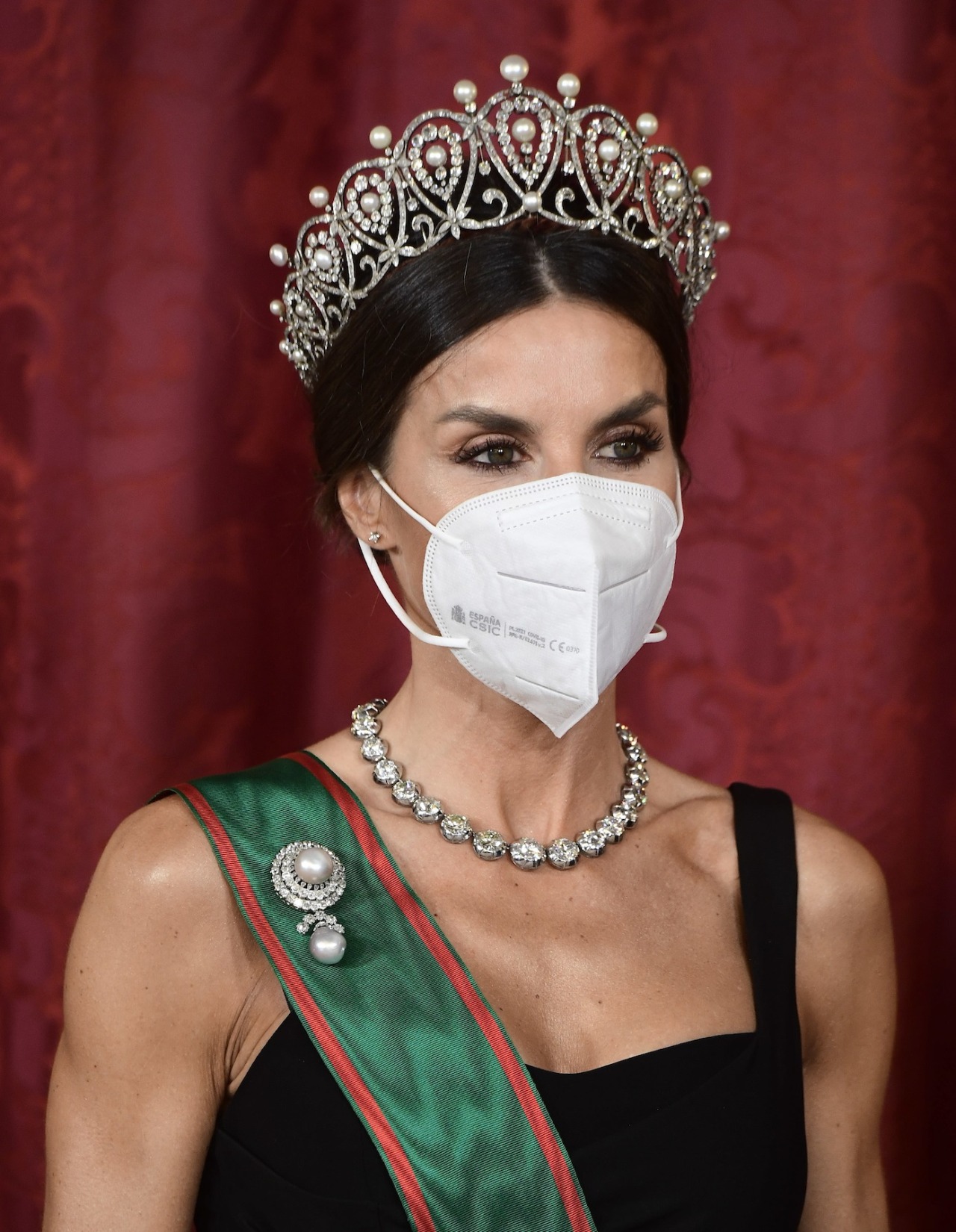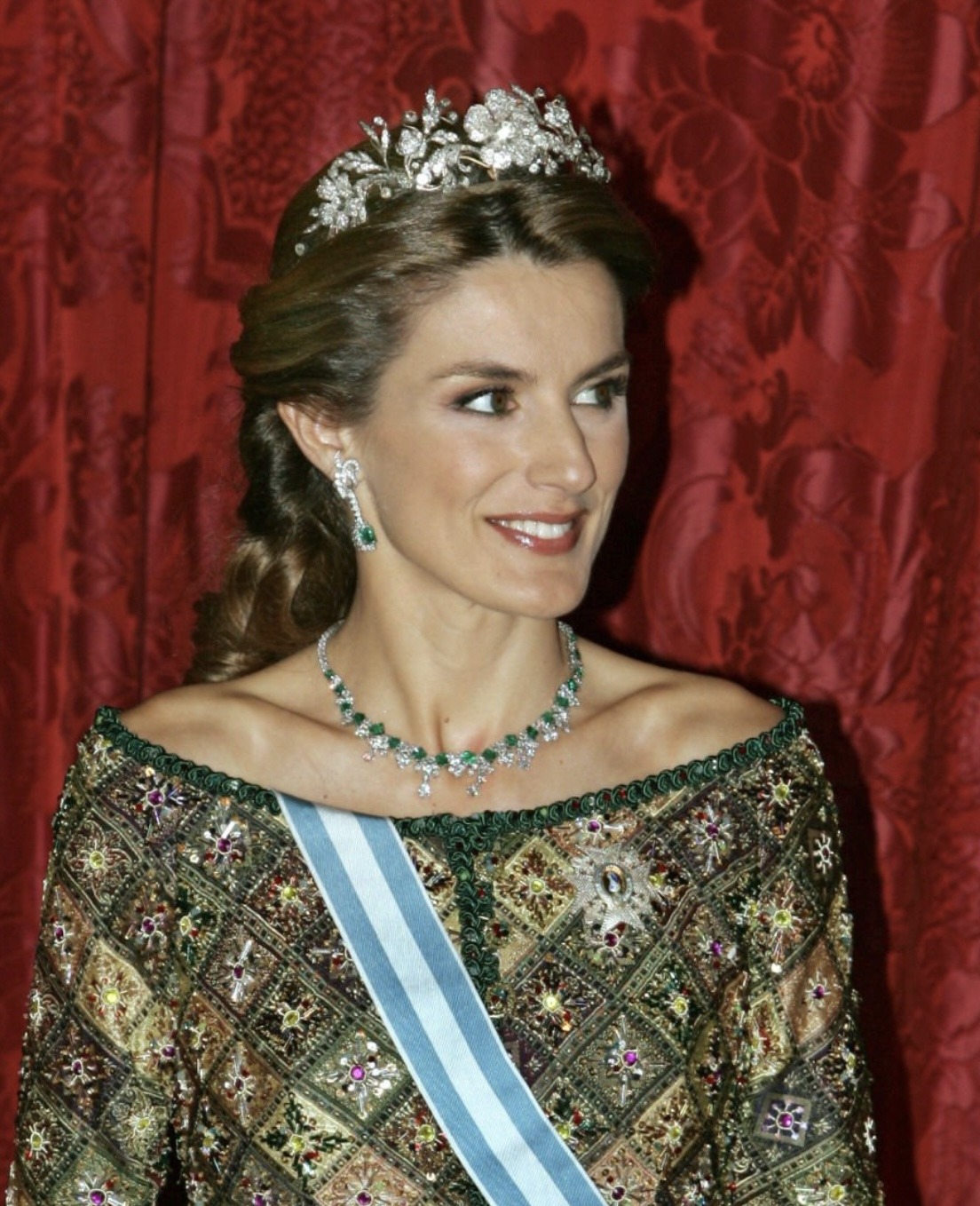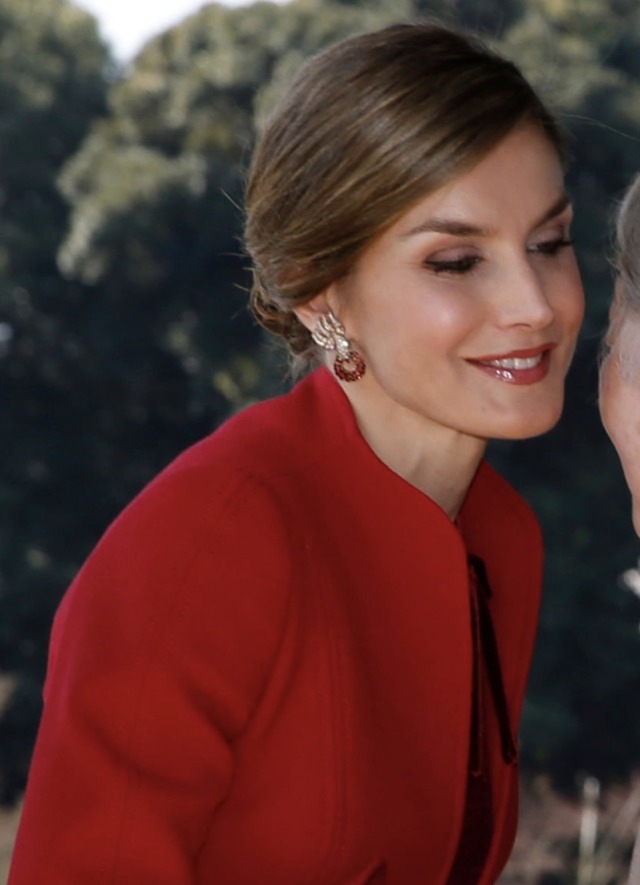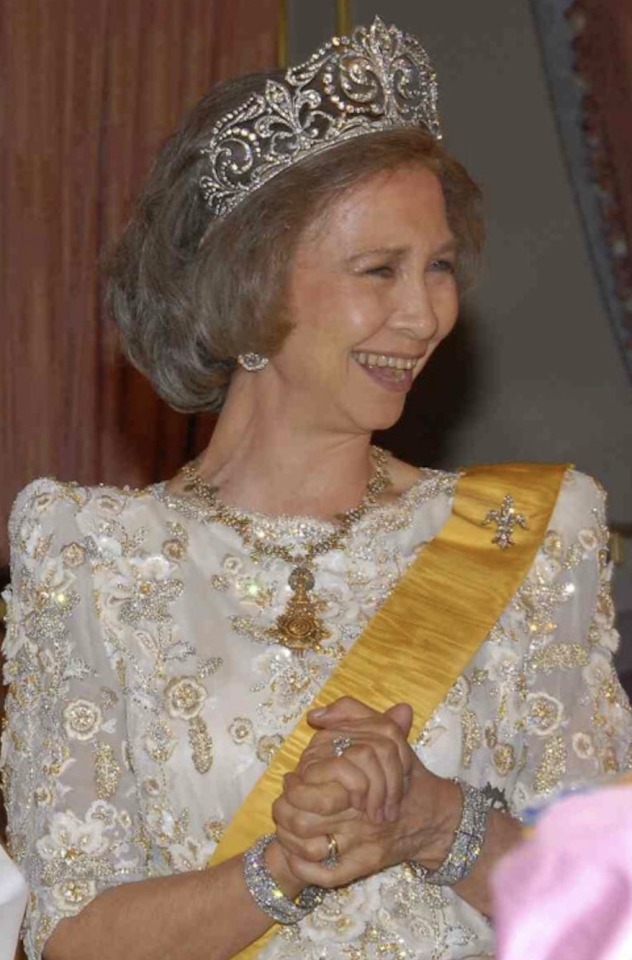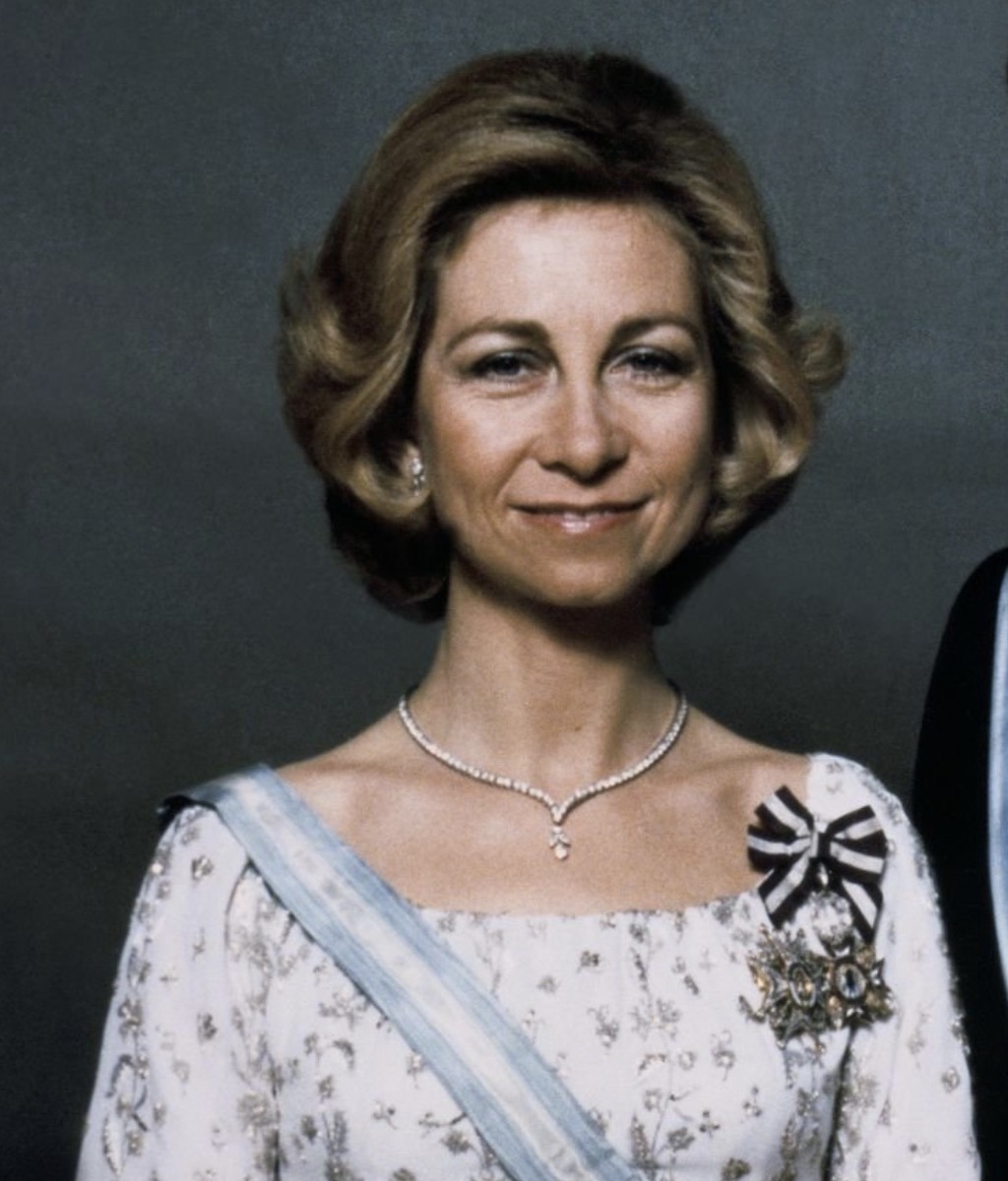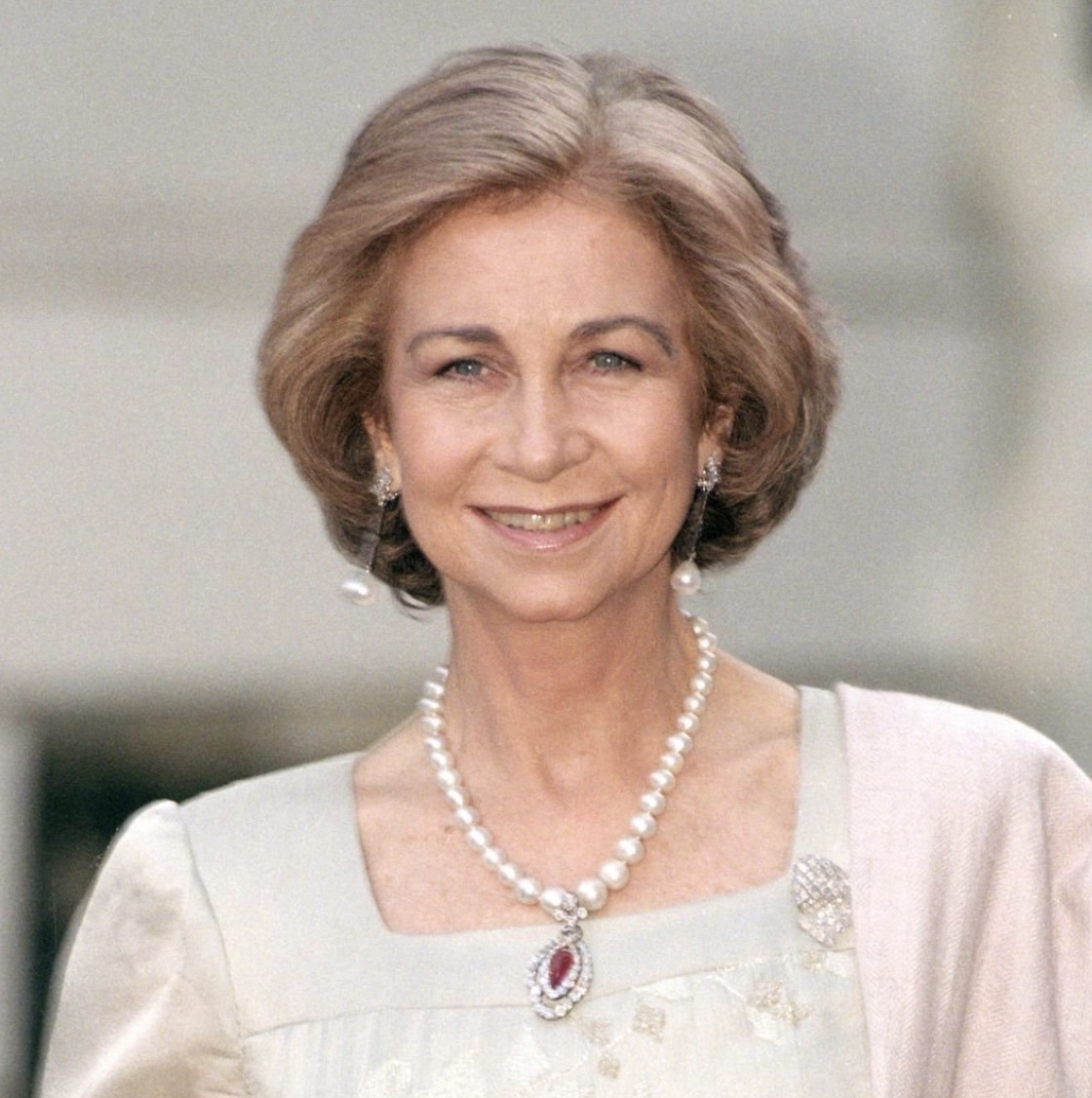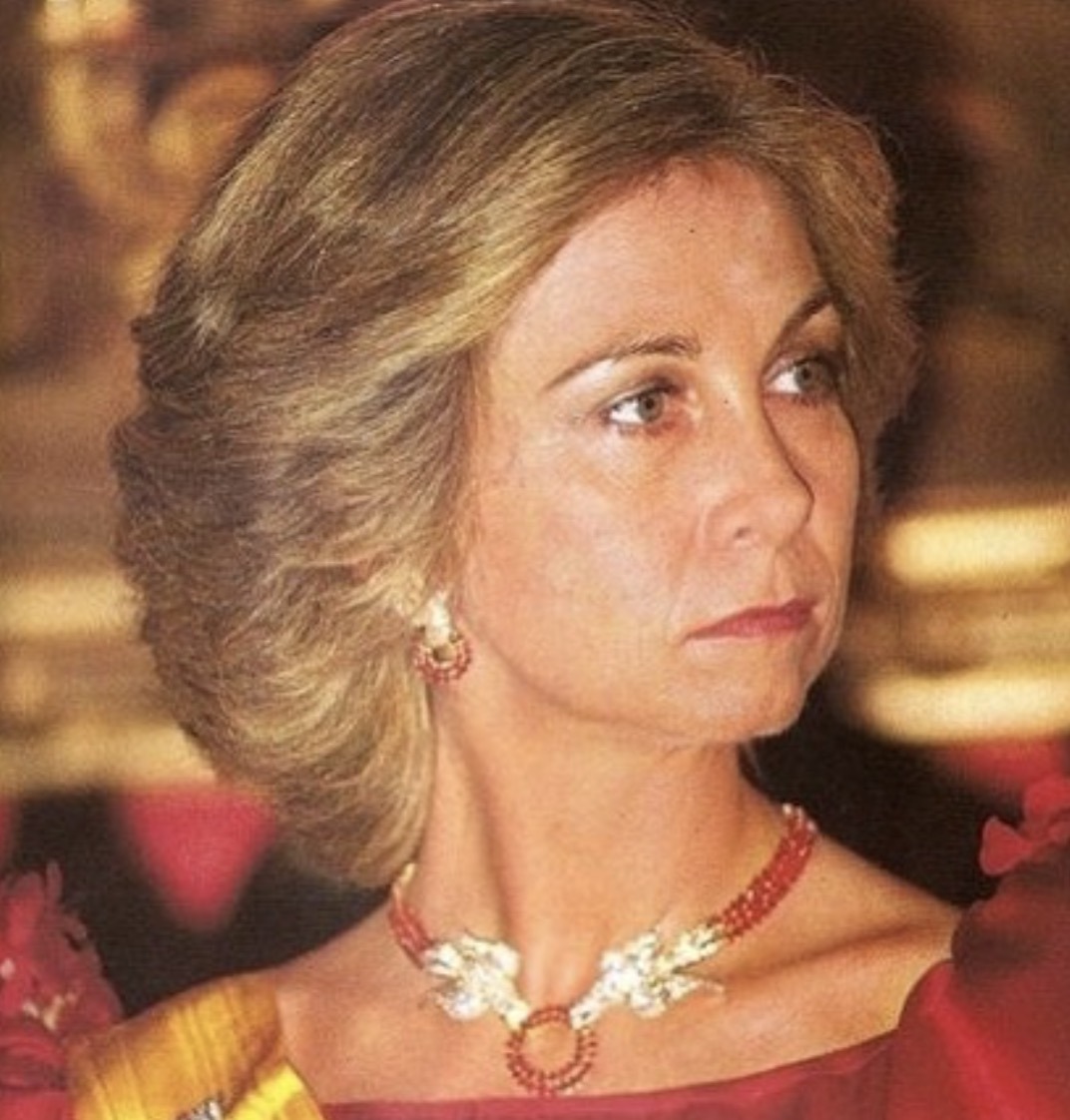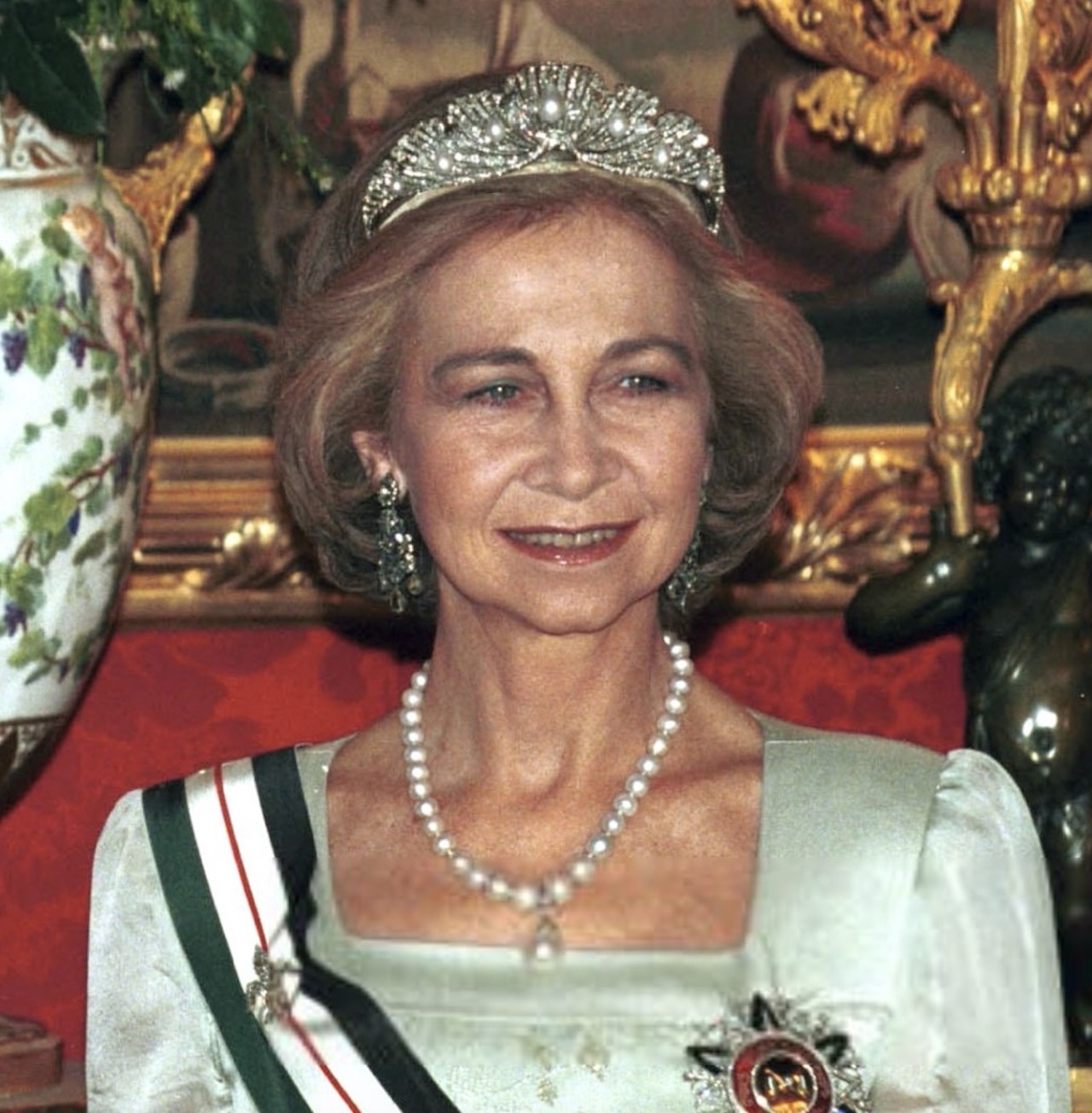Today marks the 195th Anniversary of the birth of Queen Isabella II of Spain, who was born on this day in 1830! The eldest child of King Fernando VII and his wife and niece, Maria Cristina of Bourbon-Two Sicilies, she ascended the throne at the tender age of 3, her reign earning her the title of the “queen of sad fates” due to the political turmoil and challenges that ultimately led to her exile in Paris following the Glorious Revolution of 1868. To commemorate her birthday, we are highlighting one of her most important surviving heirlooms, the Joyas de Pasar Pearl Necklace!
Diamond Star Tiara | Emerald Flower Tiara | Castillos y Leones Tiara | Joyas de Pasar Pearl Necklace | Emerald Suite | Joyas de Pasar

This outstanding jewel comprises 37 natural pearls, graduating in size from the centre to the ends. The piece is completed with an important diamond collet fermoir, adding brilliance to one of the most distinguished heirlooms of Queen Isabella II, which continues to hold a central place in the Spanish royal collection.

Queen Isabella II received her treasured pearls as a wedding gift from her cousin and husband, Francisco de Asís. The necklace – together with other jewels forming a very complete parure – had belonged to Francisco through inheritance from his late mother, Infanta Luisa Carlota, born Princess of the Two Sicilies. As contemporary press reports noted:
“We know that among the jewels that, upon the death of the Infanta Doña Luisa Carlota, passed to the family of H.R.H., was a magnificent complete parure of white pearls and diamonds, valued at five million reales, which, being too valuable to be divided among her children, was ceded by the other siblings to Infante Don Francisco de Asís to form his wedding gift, with each being compensated for their share”.



Queen Isabella II continued to wear the pearl necklace throughout her reign, and it is well known that these pearls were among her most treasured possessions. She was frequently portrayed adorned with the magnificent 37 pearls around her neck, its elegant design becoming closely associated with her image as sovereign.

After the revolution of 1868, Isabella II and the Royal Family went into exile in France. The Queen was able to take with her the full extent of her vast jewellery collection, a trove that proved invaluable during those uncertain years. The jewels were frequently used as security to obtain loans from French and British banks, helping the family to maintain a measure of stability while in exile.

Ten years later, the accumulation of debts and a pressing lack of ready cash led to a great auction in Paris of most of Queen Isabella II’s jewels, organized to secure the allowances that had to be paid to her husband and children. Among the hundreds of lots featuring remarkable stones, one could find Lot 202:
«Remarquable collier de perles composé de: un rang de trente-sept perles, pesant 1.570 grains et fermé par un gros chaton brillant. Au-dessous une splendide et unique perle formant pendant et pesant 237 grains» [“Remarkable pearl necklace composed of a row of thirty-seven pearls, weighing 1,570 grains, and closed by a large brilliant collet. Below, a splendid and unique pearl forming a pendant and weighing 237 grains”]. The piece was highlighted in the catalogue as «Très Important», underscoring its exceptional status within the sale.

Queen Isabella II was deeply attached to her treasured pearls and was determined to keep them despite the auction. Authors such as María José Rubio, in her biography of Infanta Isabel, transcribe a letter in which the Queen writes to her daughter, urging her to intervene and save her “wedding pearls” from being lost. In the letter, Isabella asks either her daughter or her brother, King Alfonso XII, to step in and ensure that these cherished jewels remain in the family, highlighting how much personal and sentimental value she placed on the necklace.
 Thanks to the remarkable research conducted by Nuria Lázaro, we now know that Queen Isabella II managed to retain her pearl necklace. To do so, a banker provided her with a loan, which she repaid in instalments, allowing the treasured piece to remain in her possession. The Queen continued to wear the necklace throughout the remaining twenty years of her life.
Thanks to the remarkable research conducted by Nuria Lázaro, we now know that Queen Isabella II managed to retain her pearl necklace. To do so, a banker provided her with a loan, which she repaid in instalments, allowing the treasured piece to remain in her possession. The Queen continued to wear the necklace throughout the remaining twenty years of her life.

After Queen Isabella II’s death in 1901, a very complicated inheritance process began. Concerning the famous pearl necklace, her grandson, King Alfonso XIII, purchased it from the estate administration, ensuring that the treasured piece remained within the royal family and preserving one of Queen Isabella’s most iconic heirlooms.

Five years later, in 1906, the pearl necklace once again served as a wedding gift. King Alfonso XIII presented his grandmother’s pearls to his bride, Princess Victoria Eugenia of Battenberg, as part of a spectacular ensemble. The necklace was given alongside a remarkable trove of jewels, including the Fleur-De-Lys Tiara, the Diamond Riviere, and a tiny Diamond Crown.

After wearing it on her wedding day, the now Queen Victoria Eugenie wore the necklace extensively, both for daytime engagements and evening gala occasions. Her Majesty was also frequently portrayed and photographed wearing the family’s pearls.



Later, as fashion evolved, the Queen had the necklace’s length altered, adding smaller pearls between the original 37 to create a style resembling a sautoir.

When the Spanish royal family went into exile in 1931, Queen Ena managed to take all her splendid jewels with her, including the pearl necklace. As fashions changed once more, she had it restored to its original configuration.

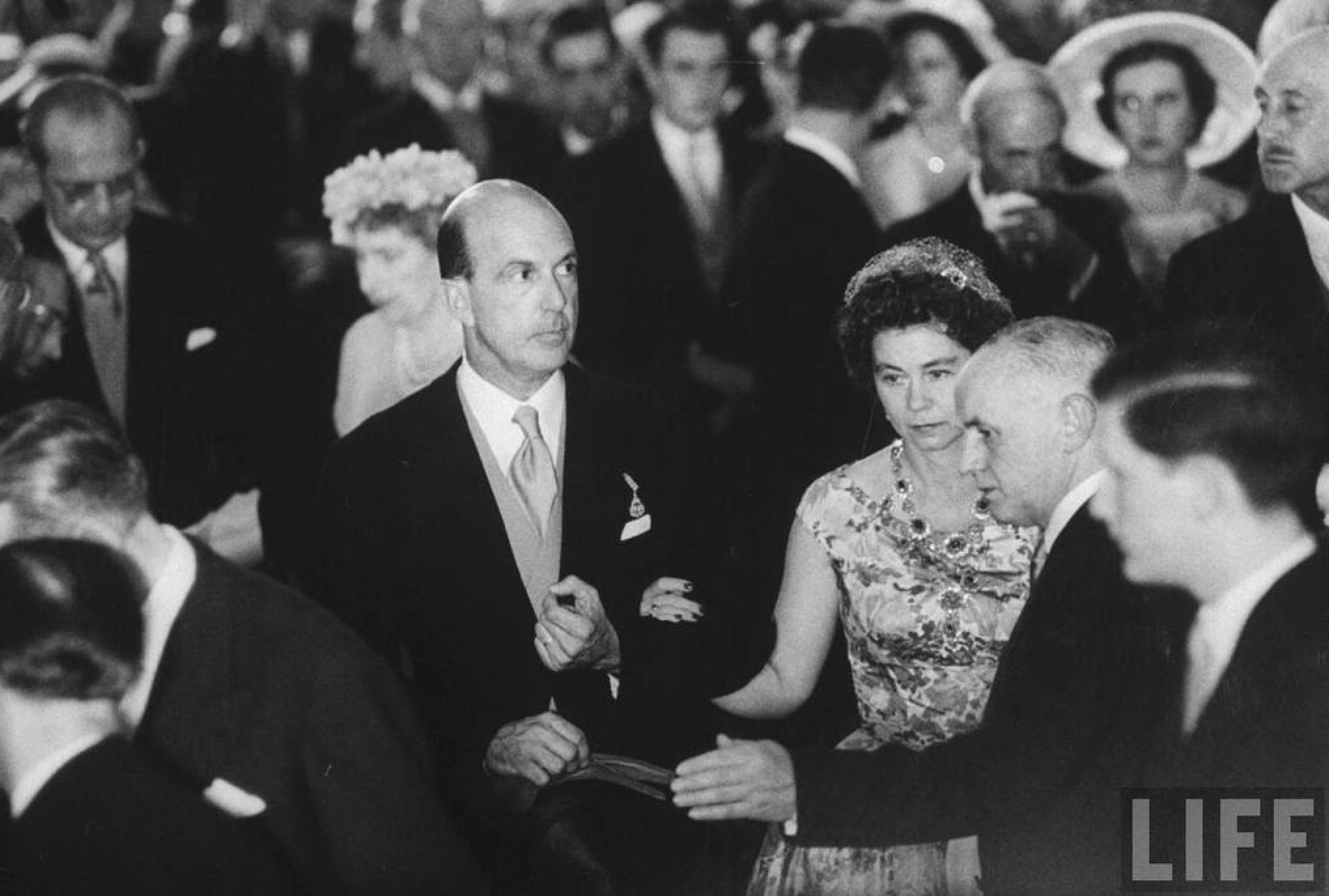

The Queen wore it extensively during her 38 years of exile. Her Majesty adorned her neck with it at several high-profile events, including the wedding of Count of Clermont and Duchess Marie-Thèrése of Wurttemberg in 1957, the wedding of the Duke of Kent in 1961, as well as wedding of Princess Alexandra of Kent in 1963.



The necklace also featured prominently in numerous Bourbon family gatherings and significant occasions, such as the wedding of Prince Juan Carlos and Princess Sofia of Greece in 1962, the wedding of Infanta Pilar in 1967, and the christening of Infante Felipe in 1968, which marked her final and only return to Spain after more than 35 years in exile.

When Queen Ena died, this necklace became part of the Joyas de Pasar, a collection of jewels reserved for the use of the Spanish queens. As there was officially no reigning king or queen during that period, the collection was kept by the head of the family and pretender to the throne, Don Juan. Several years after the restoration of the Spanish monarchy in 1975, the Count and Countess of Barcelona transferred the Joyas de Pasar to Don Juan Carlos and Doña Sofía.

Many years before, Doña María de las Mercedes had borrowed the pearls from her mother-in-law on at least one occasion: the pre-wedding celebrations of Princess Elizabeth of York and Prince Philip of Greece and Denmark in 1947.



In the intervening years, the Countess of Barcelona also wore the important pearl necklace, notably for the wedding of Crown Prince Alexander of Yugoslavia and Princess Maria da Glória of Orléans-Braganza in 1972, as well as for Infanta Margarita’s pre-wedding party on that same year, and for two banquets held in Lisbon during King Juan Carlos and Queen Sofía’s first state visit to Portugal as monarchs in 1976.

The Countess of Barcelona also loaned the Pearl Necklace, together with Queen Maria Cristina’s Pearl And Diamond Tiara and Queen Ena’s Diamond Bracelets, to Doña Sofía for the celebrations of 2500th anniversary of the Persian Empire in 1971.





Queen Sofía wore the necklace extensively throughout the 1980s and 1990s. It was probably her most worn heirloom among the historic Spanish jewel collection. Her Majesty often paired it with the family’s tiaras for state banquets at the Royal Palace of Madrid, notably for the Nepalese State Visit in 1983, the Belgian State Visit in 1994, the Japanese State Visit in 1994. The Queen also wore it on visits abroad, such as a State Visit to Japan in 1980, a State Visit to Norway in 1982.






Queen Sofía wore the necklace for the wedding of her eldest daughter, Infanta Elena, in 1995. The Queen also wore the pearls for important dynastic weddings across Europe: the wedding of the Duke of Brabant in 1999, the wedding of the Prince of Orange in 2002, and the wedding of the Crown Princess of Sweden in 2010, paired with the Mellerio Shell Tiara.







Keeping up with tradition, after the abdication of King Juan Carlos I and the accession of King Felipe VI in 2014, Queen Sofía passed the pearl necklace, along with the rest of the Joyas de Pasar collection, to the new queen consort. Since then, Queen Letizia has worn the historic family pearls on select occasions, including an official lunch offered to the German President in 2018, an official visit to Paris in 2020, the funeral of Juan Gómez Acebo, Viscount of la Torre, and, more recently, the Pascua Militar ceremony and the 2025 ABC Awards. There is no doubt we’ll continue to see the Pearl Necklace being worn for years to come!
Diamond Star Tiara | Emerald Flower Tiara | Castillos y Leones Tiara | Joyas de Pasar Pearl Necklace | Emerald Suite | Joyas de Pasar
This article was written by assistant editor, David Rato, who runs the Spanish Royal Jewels account on Instagram!

Diamond Star Tiara
Castillos y Leones Tiara
Emerald Flower Tiara
Emerald Suite
Spanish Fleur-de-Lys Tiara
Spanish Floral Tiara
Prussian Diamond Tiara
Queen Victoria Eugenie’s Cartier Pearl Tiara
Queen Maria Christina’s Loop Tiara
Mellerio Shell Tiara
Ansorena Fleur de Lys Tiara
The Joyas de Pasar
Queen Victoria Eugenie’s Diamond Earrings
Queen Victoria Eugenie’s Diamond Bracelets
Queen Victoria Eugenie’s Diamond Rivière
Queen Sofia’s Wedding Necklace
Queen Maria Cristina’s Pearl Brooch




